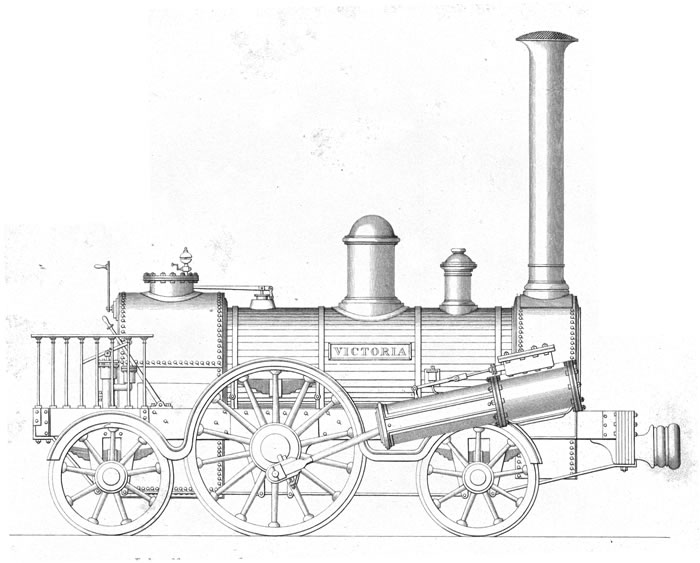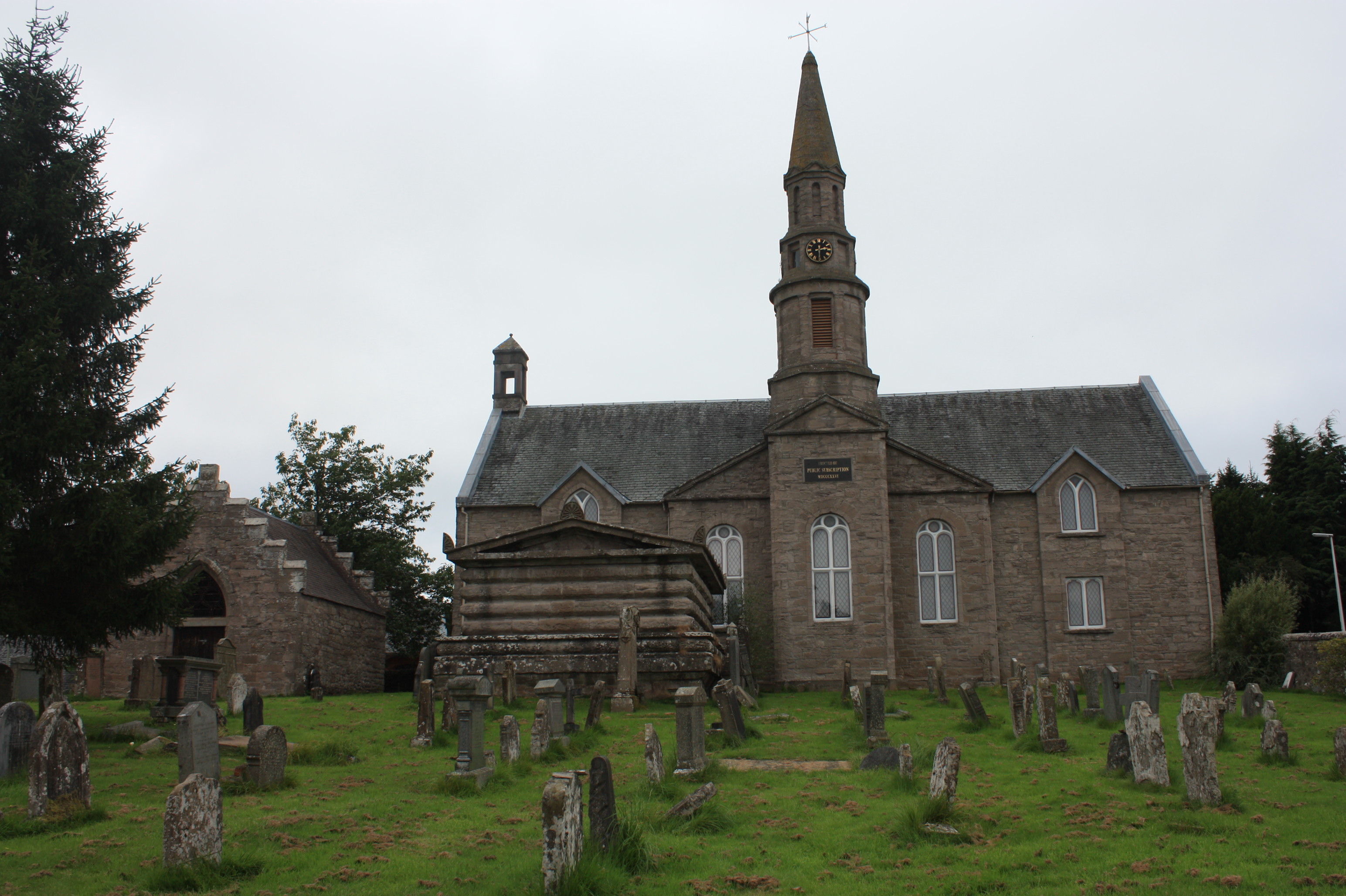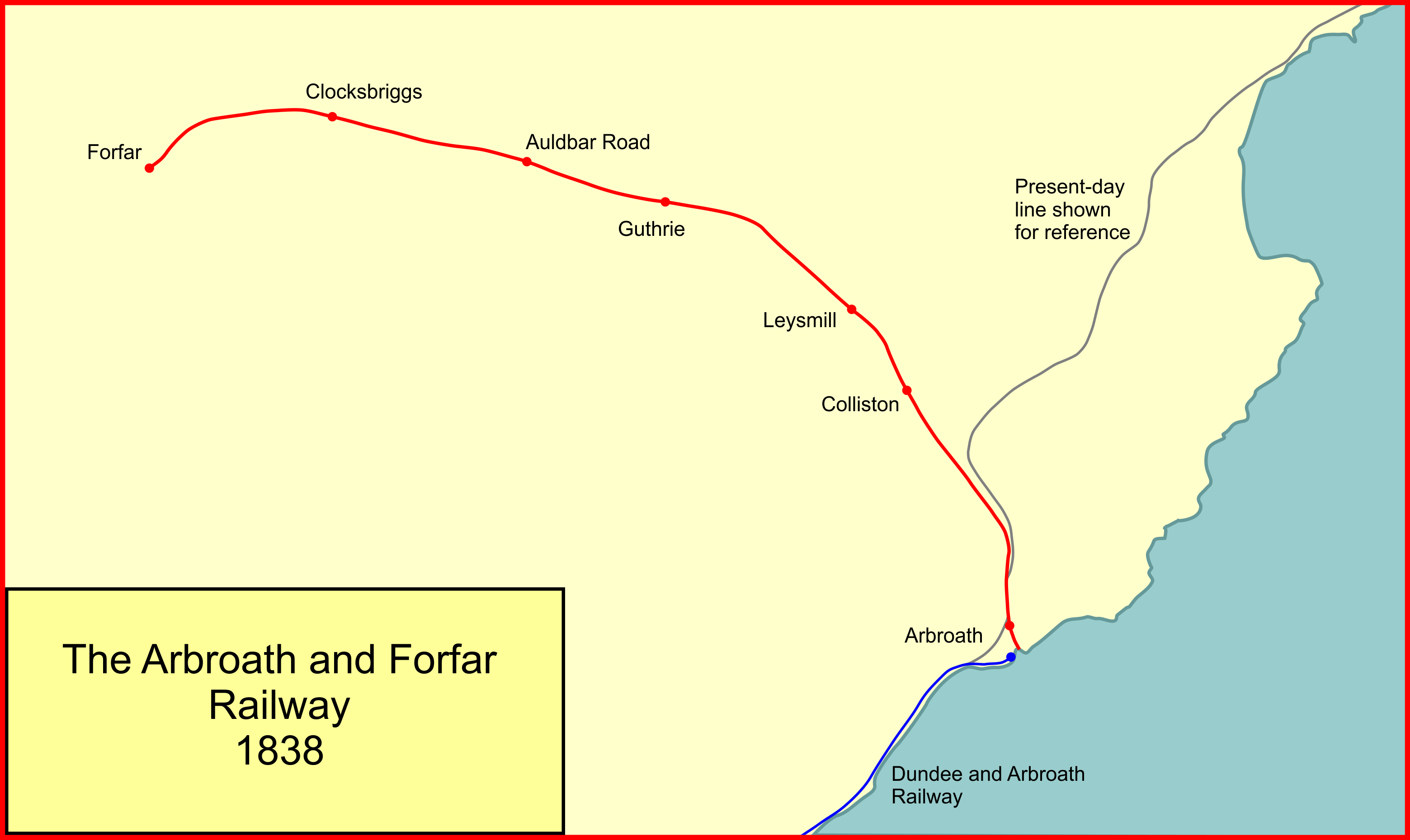|
James Stirling (engineer, Born 1799)
James Stirling (3 March 1799, Methven – 10 January 1876, Edinburgh) was a Scottish engineer, and brother of Robert Stirling. He originally specialised railway engines and later in dock gates and weirs Life He was born at Cloag Farm near Methven in Perthshire, the son of Patrick and Janet Stirling. He originally studied divinity, intending to be a minister in the Church of Scotland. However, inspired by his brother Robert, he instead decided to be an engineer, and was apprenticed to Claude Girdwood & Co in Glasgow as a mechanical engineer. The company specialised in making cotton gins. He then became manager of the Dundee Foundry, which built several locomotives for the Dundee and Newtyle Railway. In 1827 he patented, together with his brother Robert Stirling an Air engine. In 1842 he built the Dundee hot air engine. The first engine of this kind which, after various modifications, was efficiently constructed and heated, had a cylinder of 12 inches (approx. 30& ... [...More Info...] [...Related Items...] OR: [Wikipedia] [Google] [Baidu] |
Methven, Perth And Kinross
Methven (; gd, Meadhainnigh) is a large village in the Scottish region of Perth and Kinross, on the A85 road due west of the town of Perth. It is near the village of Almondbank. The village has its own primary school, church, bowling club, community halls, playing field with sports facilities and skate-park, and a variety of businesses. There is a local primary school in the village, and a large co-educational boarding and day independent school nearby, called Glenalmond College, described by '' The Good Schools Guide'' as providing an "outstanding" quality of education. Etymology A Brittonic name, ''Methven'' is thought to be derived from words equivalent to Welsh ''medd'' "mead", and ''maen'' (in this case, mutated to ''faen'') "stone". Businesses To the south of the village, along Station Road, a small industrial estate occupies the former site of Methven Station. Closed since 27 September 1937, the station was originally the western terminus of the Perth, Almond Valle ... [...More Info...] [...Related Items...] OR: [Wikipedia] [Google] [Baidu] |
Hot Air Engine
A hot air engine (historically called an air engine or caloric engine) is any heat engine that uses the expansion and contraction of air under the influence of a temperature change to convert thermal energy into mechanical work. These engines may be based on a number of thermodynamic cycles encompassing both open cycle devices such as those of Sir George Cayley and John Ericsson and the closed cycle engine of Robert Stirling. Hot air engines are distinct from the better known internal combustion based engine and steam engine. In a typical implementation, air is repeatedly heated and cooled in a cylinder and the resulting expansion and contraction are used to move a piston and produce useful mechanical work. Definition The term "hot air engine" specifically excludes any engine performing a thermodynamic cycle in which the working fluid undergoes a phase transition, such as the Rankine cycle. Also excluded are conventional internal combustion engines, in which heat is ... [...More Info...] [...Related Items...] OR: [Wikipedia] [Google] [Baidu] |
1876 Deaths
Events January–March * January 1 ** The Reichsbank opens in Berlin. ** The Bass Brewery Red Triangle becomes the world's first registered trademark symbol. * February 2 – The National League of Professional Base Ball Clubs is formed at a meeting in Chicago; it replaces the National Association of Professional Base Ball Players. Morgan Bulkeley of the Hartford Dark Blues is selected as the league's first president. * February 2 – Third Carlist War – Battle of Montejurra: The new commander General Fernando Primo de Rivera marches on the remaining Carlist stronghold at Estella, where he meets a force of about 1,600 men under General Carlos Calderón, at nearby Montejurra. After a courageous and costly defence, Calderón is forced to withdraw. * February 14 – Alexander Graham Bell applies for a patent for the telephone, as does Elisha Gray. * February 19 – Third Carlist War: Government troops under General Primo de Rivera drive through the ... [...More Info...] [...Related Items...] OR: [Wikipedia] [Google] [Baidu] |
1800 Births
Eighteen or 18 may refer to: * 18 (number), the natural number following 17 and preceding 19 * one of the years 18 BC, AD 18, 1918, 2018 Film, television and entertainment * ''18'' (film), a 1993 Taiwanese experimental film based on the short story ''God's Dice'' * ''Eighteen'' (film), a 2005 Canadian dramatic feature film * 18 (British Board of Film Classification), a film rating in the United Kingdom, also used in Ireland by the Irish Film Classification Office * 18 (''Dragon Ball''), a character in the ''Dragon Ball'' franchise * "Eighteen", a 2006 episode of the animated television series ''12 oz. Mouse'' Music Albums * ''18'' (Moby album), 2002 * ''18'' (Nana Kitade album), 2005 * '' 18...'', 2009 debut album by G.E.M. Songs * "18" (5 Seconds of Summer song), from their 2014 eponymous debut album * "18" (One Direction song), from their 2014 studio album ''Four'' * "18", by Anarbor from their 2013 studio album '' Burnout'' * "I'm Eighteen", by Alice Cooper commonly ... [...More Info...] [...Related Items...] OR: [Wikipedia] [Google] [Baidu] |
St Andrews University
(Aien aristeuein) , motto_lang = grc , mottoeng = Ever to ExcelorEver to be the Best , established = , type = Public research university Ancient university , endowment = £117.7 million (2021) , budget = £286.6 million (2020–21) , chancellor = The Lord Campbell of Pittenweem , rector = Leyla Hussein , principal = Sally Mapstone , academic_staff = 1,230 (2020) , administrative_staff = 1,576 , students = () , undergrad = () , postgrad = () , doctoral = , other = , city = St Andrews , state = , country = Scotland , coordinates = , campus = College town , colours = United College, St Andrews St Mary's College School of Medicine ... [...More Info...] [...Related Items...] OR: [Wikipedia] [Google] [Baidu] |
Newtyle And Coupar Angus Railway
The Scottish Midland Junction Railway was authorised in 1845 to build a line from Perth to Forfar. Other companies obtained authorisation in the same year, and together they formed a route from central Scotland to Aberdeen. The SMJR opened its main line on 4 August 1848. Proposals to merge with other railways were rejected by Parliament at first, but in 1856 the SMJR merged with the Aberdeen Railway to form the Scottish North Eastern Railway. The SNER was itself absorbed into the larger Caledonian Railway in 1866. The original SMJR main line was now a small section of a main line from Carlisle and central Scotland to Aberdeen. The original route was well aligned for fast running, but it by-passed numerous towns and many branches were built to serve them. The rival North British Railway had its own route from the south to Aberdeen, and spectacular competition for the fastest journey from London to Aberdeen was generated in the final decades of the nineteenth century. In the 196 ... [...More Info...] [...Related Items...] OR: [Wikipedia] [Google] [Baidu] |
Arbroath And Forfar Railway
The Arbroath and Forfar Railway was a railway that connected Forfar with the port town of Arbroath, in Scotland. It opened in 1838–1839 and it was successful in making an operating profit, but it was always desperately short of capital. It used the track gauge of . When the Aberdeen Railway was authorised in 1845, it leased the Arbroath and Forfar line to form part of its main line connecting Forfar and Aberdeen; it opened in 1848. The Aberdeen Railway was to be a standard gauge line and the A&FR had to alter its track gauge. The A&FR line formed part of the main line from Stirling to Aberdeen, and when the North British Railway started running to Aberdeen in 1881, their trains too ran over a very short section of the A&FR. Nearly all of the A&FR line was closed in 1967 when the former NBR route was selected as the only route to Aberdeen, and the short section immediately north of Arbroath is the only section of the A&FR still in use. History Conception and authorisation I ... [...More Info...] [...Related Items...] OR: [Wikipedia] [Google] [Baidu] |
2-2-2
Under the Whyte notation for the classification of steam locomotives, 2-2-2 represents the wheel arrangement of two leading wheels on one axle, two powered driving wheels on one axle, and two trailing wheels on one axle. The wheel arrangement both provided more stability and enabled a larger firebox than the earlier 0-2-2 and 2-2-0 types. This configuration was introduced in 1834 on Robert Stephenson's ' Patentee locomotive' but it was later popularly named Jenny Lind, after the Jenny Lind locomotive which in turn was named after the popular singer. They were also sometimes described as Singles, although this name could be used to describe any kind of locomotive with a single pair of driving wheels. Equivalent classifications Other equivalent classifications are: * UIC classification: 1A1 (also known as German classification and Italian classification) *French classification: 111 *Turkish classification: 13 *Swiss classification: 1/3 History The 2-2-2 configuration appears ... [...More Info...] [...Related Items...] OR: [Wikipedia] [Google] [Baidu] |
Steam Locomotives
A steam locomotive is a locomotive that provides the force to move itself and other vehicles by means of the expansion of steam. It is fuelled by burning combustible material (usually coal, oil or, rarely, wood) to heat water in the locomotive's boiler to the point where it becomes gaseous and its volume increases 1,700 times. Functionally, it is a steam engine on wheels. In most locomotives, the steam is admitted alternately to each end of its cylinders, in which pistons are mechanically connected to the locomotive's main wheels. Fuel and water supplies are usually carried with the locomotive, either on the locomotive itself or in a tender coupled to it. Variations in this general design include electrically-powered boilers, turbines in place of pistons, and using steam generated externally. Steam locomotives were first developed in the United Kingdom during the early 19th century and used for railway transport until the middle of the 20th century. Richard Trevithick bui ... [...More Info...] [...Related Items...] OR: [Wikipedia] [Google] [Baidu] |
Dean Cemetery
The Dean Cemetery is a historically important Victorian cemetery north of the Dean Village, west of Edinburgh city centre, in Scotland. It lies between Queensferry Road and the Water of Leith, bounded on its east side by Dean Path and on its west by the Dean Gallery. A 20th-century extension lies detached from the main cemetery to the north of Ravelston Terrace. The main cemetery is accessible through the main gate on its east side, through a "grace and favour" access door from the grounds of Dean Gallery and from Ravelston Terrace. The modern extension is only accessible at the junction of Dean Path and Queensferry Road. The cemetery Dean Cemetery, originally known as Edinburgh Western Cemetery, was laid out by David Cousin (an Edinburgh architect who also laid out Warriston Cemetery) in 1846 and was a fashionable burial ground for mainly the middle and upper-classes. The many monuments bear witness to Scottish achievement in peace and war, at home and abroad and are ... [...More Info...] [...Related Items...] OR: [Wikipedia] [Google] [Baidu] |
New Town, Edinburgh
The New Town is a central area of Edinburgh, the capital of Scotland. It was built in stages between 1767 and around 1850, and retains much of its original neo-classical and Georgian period architecture. Its best known street is Princes Street, facing Edinburgh Castle and the Old Town across the geological depression of the former Nor Loch. Together with the West End, the New Town was designated a UNESCO World Heritage Site alongside the Old Town in 1995. The area is also famed for the New Town Gardens, a heritage designation since March 2001. Proposal and planning The idea of a New Town was first suggested in the late 17th century when the Duke of Albany and York (later King James VII and II), when resident Royal Commissioner at Holyrood Palace, encouraged the idea of having an extended regality to the north of the city and a North Bridge. He gave the city a grant:That, when they should have occasion to enlarge their city by purchasing ground without the town, or to b ... [...More Info...] [...Related Items...] OR: [Wikipedia] [Google] [Baidu] |
Dundee
Dundee (; sco, Dundee; gd, Dùn Dè or ) is Scotland's fourth-largest city and the 51st-most-populous built-up area in the United Kingdom. The mid-year population estimate for 2016 was , giving Dundee a population density of 2,478/km2 or 6,420/sq mi, the second-highest in Scotland. It lies within the eastern central Lowlands on the north bank of the Firth of Tay, which feeds into the North Sea. Under the name of Dundee City, it forms one of the 32 council areas used for local government in Scotland. Within the boundaries of the historic county of Angus, the city developed into a burgh in the late 12th century and established itself as an important east coast trading port. Rapid expansion was brought on by the Industrial Revolution, particularly in the 19th century when Dundee was the centre of the global jute industry. This, along with its other major industries, gave Dundee its epithet as the city of "jute, jam and journalism". Today, Dundee is promoted as "One ... [...More Info...] [...Related Items...] OR: [Wikipedia] [Google] [Baidu] |









